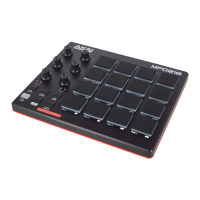5
8. Note Repeat: Press and hold this button while striking a pad to cause the pad to
retrigger at a rate based on the current tempo and Time Division settings.
Tip: You can sync Note Repeat to an internal or external MIDI clock source. See the
description for Note Repeat Configuration (NR Config) to learn how to do this.
9. Note Repeat Configuration (NR Config): Press this button and then press a pad to
select its secondary function (printed next to the pad number).
Important: While holding this button, the pads will not send any of their normal MIDI
messages.
• Pads 1–8: Press one of these pads to determine Time Division, which determines
the rate of the Note Repeat feature: quarter notes (1/4), eighth notes (1/8), 16th
notes (1/16), or 32nd notes (1/32). On Pads 5–8, the T indicates a triplet-based time
division.
• Pads 9–14: Press one of these pads to select the amount of Swing: Off, 54%, 56%,
58%, 60%, or 62%.
• Pad 15 (Ext Clock): Press this pad to set MPD218’s clock source (external or
internal), which will determine the rate of its time-related features. When lit (external),
MPD218 will use your DAW’s tempo. When off (internal), MPD218 will use its own
tempo, which you can set with Pad 16, which will flash at the current tempo.
• Pad 16 (Tap Tempo): Press this pad at the desired rate to enter a new tempo.
MPD218 will detect the new tempo after 3 taps. The pad will flash at the current
tempo if you hold NR Config and if MPD218 is using its internal clock.
10. Program Select (Prog Select): Press and hold this button and then press a pad to select
the Program with the same number as the pad. A Program is a pre-mapped layout of
pads, which can be useful for specific situations (using a General MIDI drum set or using
a specific melodic scale).
Important:
While holding this button, the pads will not send any of their normal MIDI messages.
Visit akaipro.com and find the webpage for MPD218 to download the MPD218 Preset
Documentation.

